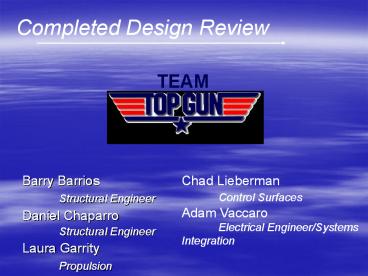Barry Barrios - PowerPoint PPT Presentation
Title:
Barry Barrios
Description:
Completed Design Review TEAM Chad Lieberman Control Surfaces Adam Vaccaro Electrical Engineer/Systems Integration Barry Barrios Structural Engineer Daniel Chaparro – PowerPoint PPT presentation
Number of Views:51
Avg rating:3.0/5.0
Title: Barry Barrios
1
Completed Design Review
Chad Lieberman Control Surfaces Adam
Vaccaro Electrical Engineer/Systems Integration
- Barry Barrios
- Structural Engineer
- Daniel Chaparro
- Structural Engineer
- Laura Garrity
- Propulsion
2
Design Objective
The goal of our CDR and the meeting we held
between the PDR and CDR was to finalize our
design. We aimed at creating a lightweight craft
that was maneuverable and quick. To help meet
these goals, we lightened the truss system by
decreasing supports, and instead of torque arms
for steering we are using motor/servo linkages
that will rotate and direct the thrust.
3
(No Transcript)
4
(No Transcript)
5
(No Transcript)
6
Pitch Control
- A servo will pivot the big motor up or down.
- Vector thrust from the big motor will raise or
lower tail of blimp to adjust altitude.
By Chad Lieberman
7
Roll Control
- The center of mass will lie in the middle of the
bottom of the truss structure so that the blimp
will not naturally roll in either direction to
achieve equilibrium. - The balloons will be held in a net-like structure
and secured to both the top and bottom of the
truss structure to minimize a swaying motion that
would cause a roll.
8
Yaw Control
- Second Servo will pivot small motor left or
right. - Vector thrust will steer the front of the blimp
left or right to control movement about the
lateral axis.
By Chad Lieberman
9
Aerodynamic Analysis
Vehicle Weight
Quantity 1 1 2 1 2 1 1 3 1
Weight 90 g 210 g 5.2 g 27 g 43 g 90 g 180 g 30
g 322 g 1205 g
Small Motor Big Motor Propeller Receiver Servos Re
ceiver Battery 9.6V Battery Balloons Wood
Frame Total
10
Aerodynamic Analysis
Helium Required
Lift (?air ?helium)gV Helium Density
0.174 kg/m3 Air Density 1.25 kg/m3 g
gravitational constant 9.81 m/s2 V Volume of
helium used Volume Helium Required 1.47
m3 Volume per balloon .52 m3 (assuming 1.5 kg
total weight including payload)
11
Aerodynamic Analysis
Estimated Time
Max Thrust .95 N Max velocity T
(.5Scd)1/2
vmax 0.93 m/s Distance 87.78 m Timestraight
line 94 s Timetotal 120 s
12
Evolution of Design
- Moved motors to a more central location to
increase stability of design - Lowered motors below main truss structure to
allow more room for them to move and in order to
avoid the air movement they create disrupting the
balloons paths and stability - Removed large stabilizer in an effort to
decrease weight and nonessential parts
13
Evolution of Design
- Decided to put battery pack and receiver and all
payload possible in one central control systems
and payload storage area - Decided that even with extra airflow generated
by motor elevator wasnt guaranteed to work, so
removed it - Kept three-balloon-in-a-row design due to
required lift and desired maneuverability - Altered truss structure a little to increase
strength and decrease weight
14
Conclusion
Our design process has been a series of
compromises between strength, weight, speed,
maneuverability and feasibility. Our final
design sacrifices some structural support in
favor of weight, and we use fewer motors than
originally planned. We feel the method of
control we are using will be more effective and
lighter weight than using torque arms. Final
adjustments will depend on trials day and how the
balloons perform with our craft.

